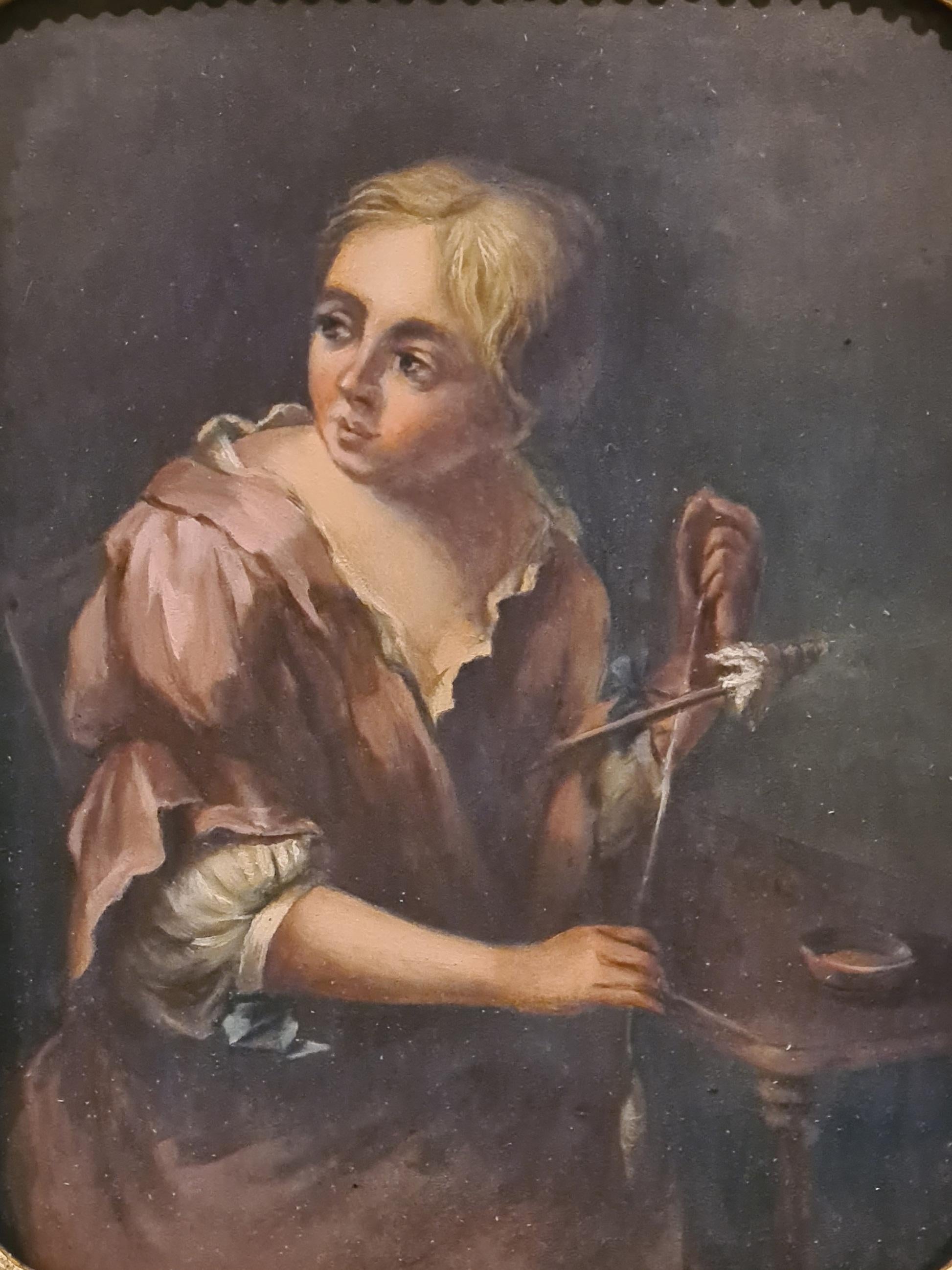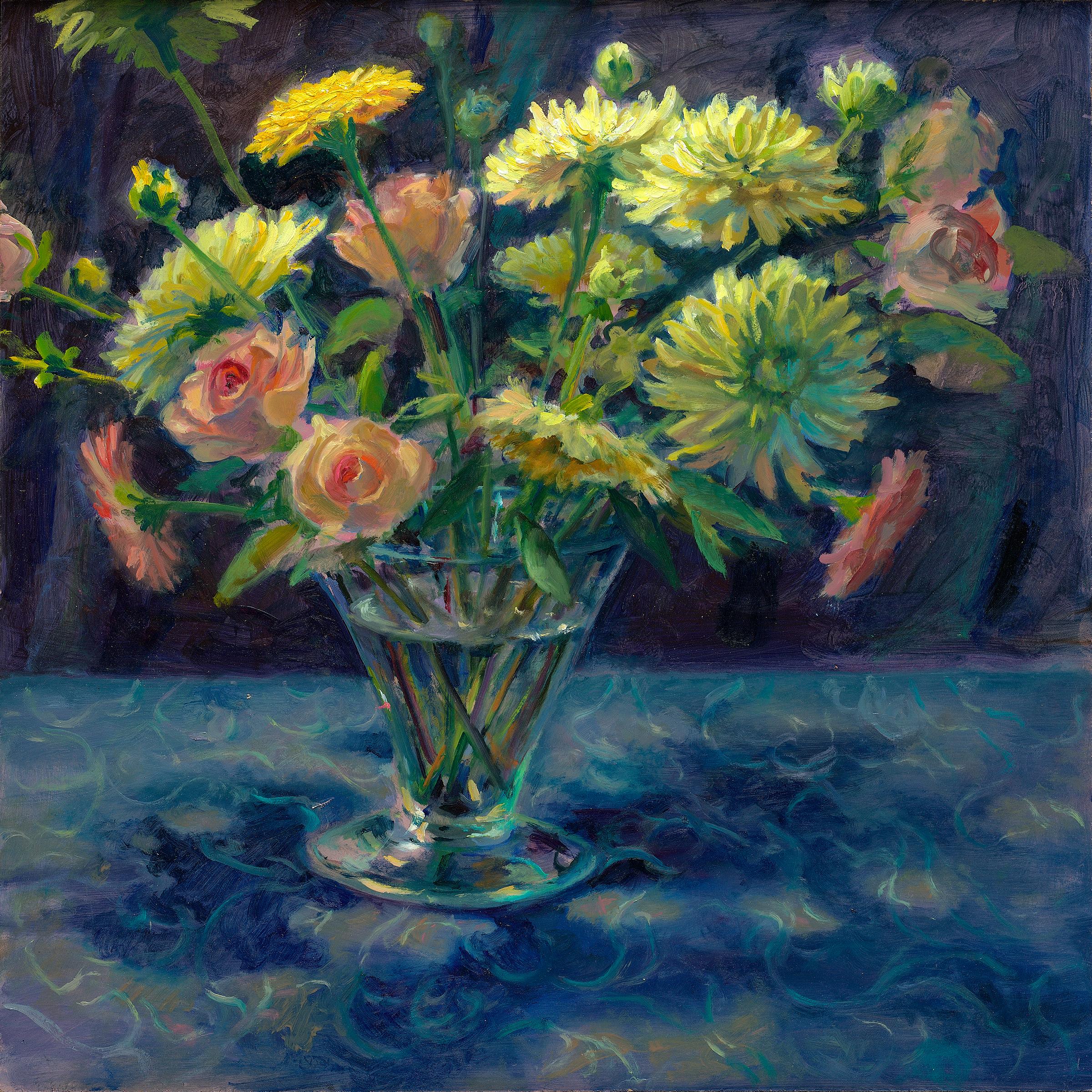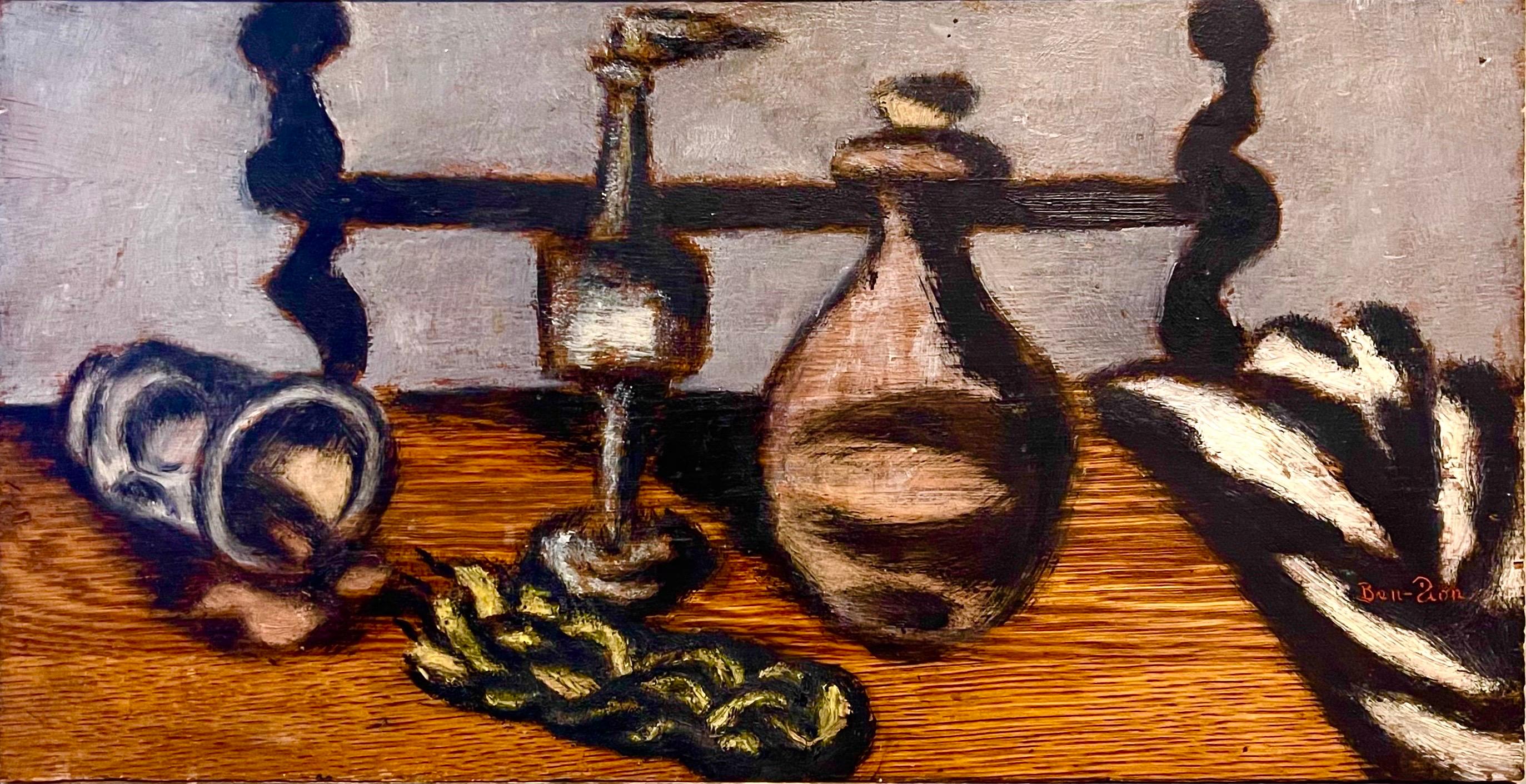Harry Humphrey MooreInterior of a Japanese House1881
1881
About the Item
- Creator:Harry Humphrey Moore (1844 - 1926, American)
- Creation Year:1881
- Dimensions:Height: 6.63 in (16.85 cm)Width: 10.63 in (27.01 cm)
- Medium:
- Period:
- Condition:
- Gallery Location:New York, NY
- Reference Number:
Harry Humphrey Moore
Born deaf in New York City, Harry Humphrey Moore was a student of Thomas Eakins when attending a school for the deaf in Philadelphia. Eakins recommended he study at École des Beaux-Arts in Paris where he became a student of Jean-Léon Gérôme.
Completing his studies in 1869, Moore traveled in Spain with Eakins, and he was so impressed by the landscape that he stayed several years. In 1872, he married and moved to Morocco and also went to Japan, having been encouraged by the artist Robert Blum.
Moore’s reputation was established by his interest in Oriental subject matter — along with William Heine, Edward Kern and Winckworth Allan Gay, Moore was one of the first American artists to visit Japan. There he created about sixty paintings of Oriental subject matter including temples, gardens and Geisha girls.
Throughout his life, Moore was a world traveler, spending much of his time in Paris, but returned to America to spend time in San Francisco between 1864 and 1907.
Find original Harry Humphrey Moore paintings and other art on 1stDibs.
- ShippingRetrieving quote...Ships From: New York, NY
- Return PolicyA return for this item may be initiated within 7 days of delivery.
- 517 East 117th StreetBy Marc TrujilloLocated in New York, NYEvery detail in Trujillo’s fast-paced, consumer-driven environments is the result of slow painting, of careful and keen observation, both analytic and synthetic. Trujillo depicts his...Category
2010s Contemporary Interior Paintings
MaterialsMetal
- John F. Kennedy International AirportBy Marc TrujilloLocated in New York, NYEvery detail in Trujillo’s fast-paced, consumer-driven environments is the result of slow painting, of careful and keen observation, both analytic and synthetic. Trujillo depicts his...Category
2010s Contemporary Interior Paintings
MaterialsOil, Panel
- The Japanese CornerBy Elliott DaingerfieldLocated in New York, NYA child of the American South, Elliott Daingerfield was born in Harper’s Ferry, Virginia, and raised in Fayetteville, North Carolina, where his father, C...Category
19th Century American Impressionist Interior Paintings
MaterialsCanvas, Oil
- Distant VoicesBy John MooreLocated in New York, NYJohn Moore was born in St. Louis, MO in 1941. He received a BFA from Washington University in St. Louis (1966) and an MFA from Yale University (1968). Over a career spanning forty ye...Category
2010s Contemporary Interior Paintings
MaterialsCanvas, Oil
- ClearingBy John MooreLocated in New York, NYJohn Moore was born in St. Louis, MO in 1941. He received a BFA from Washington University in St. Louis (1966) and an MFA from Yale University (1968). Over a career spanning forty ye...Category
2010s Contemporary Interior Paintings
MaterialsCanvas, Oil
- Peek-a-BooBy Seymour Joseph GuyLocated in New York, NYIn the latter half of the nineteenth century and into the first decade of the twentieth, New York City art aficionados could count on finding recent work of Seymour Joseph Guy hanging on the walls of the city’s major galleries. Primarily a genre artist, but also a portraitist, between 1859 and 1908 Guy showed more than seventy works at the National Academy of Design. From 1871 to 1903 he contributed over seventy times to exhibitions at the Century Club. From 1864 to 1887, he sent about forty pictures to the Brooklyn Art Association. A good number of these works were already privately owned; they served as advertisements for other pictures that were available for sale. Some pictures were shown multiple times in the same or different venues. Guy was as easy to find as his canvases were omnipresent. Though he lived at first in Brooklyn with his family and then in New Jersey, from 1863 to his death in 1910 he maintained a studio at the Artist’s Studio Building at 55 West 10th Street, a location that was, for much of that period, the center of the New York City art world. Guy’s path to a successful career as an artist was by no means smooth or even likely. Born in Greenwich, England, he was orphaned at the age of nine. His early interest in art was discouraged by his legal guardian, who wanted a more settled trade for the young man. Only after the guardian also died was Guy free to pursue his intention of becoming an artist. The details of Guy’s early training in art are unclear. His first teacher is believed to have been Thomas Buttersworth...Category
19th Century American Realist Figurative Paintings
MaterialsCanvas, Oil
- Subconscious N0507.16Located in New York, NYA painting on wood panel, 96x72". Known for his erratic and expressive abstract works, Daniel Diaz-Tai uses various mixed media including sumi ink and...Category
2010s Abstract Abstract Paintings
MaterialsWood Panel, Ink, Sumi Ink, Oil
- Yarn Spinner, in the manner of Pietro LonghiLocated in Cotignac, FREarly 19th century oil on panel portrait of a young girl spinning. Pietro Longhi was a Venetian painter who mastered the portrayal of scenes of everyda...Category
19th Century Rococo Interior Paintings
MaterialsOil, Wood Panel
- Yellow Gerbera's - 21st Century Contemporary Dutch Flower Still-life PaintingBy Keimpe van der KooiLocated in Nuenen, Noord BrabantKeimpe van der Kooi Yellow Gerbera's 50 x 50 cm Framed: 55x 55 cm ( This frame is included) Oil on wood panel This Painting is made by Dutch Artist Keimpe van der Kooi. He likes to...Category
2010s Contemporary Still-life Paintings
MaterialsWood Panel, Oil
- "The Painter and his Model", 19th C. Oil on Mahogany Wood Panel by E. L. GarridoBy Eduardo Leon GarridoLocated in Madrid, ESEDUARDO LEÓN GARRIDO Spanish, 1856- 1949 THE PAINTER AND HIS MODEL signed "E. L Garrido" (lower right) oil on mahogany wood panel 19-3/4 x 24-1/8 inches (50 x 61 cm.) framed: 28-1/2 x 32-3/4 inches (72 x 83 cm.) PROVENANCE Private Spanish Collector Eduardo León Garrido (Madrid, 1856 - Caen, 1949) was a Spanish painter. He began his training at the Higher School of Painting in Madrid and as a disciple in Vicente Palmaroli...Category
Early 1900s Realist Figurative Paintings
MaterialsWood Panel, Oil
- Eduardo León Garrido, "An Elegant Dance", 19th C. Oil on Mahogany Wood PanelBy Eduardo Leon GarridoLocated in Madrid, ESEDUARDO LEÓN GARRIDO Spanish, 1856- 1949 AN ELEGANT DANCE signed "E. L Garrido" (lower right) oil on mahogany wood panel 25-1/8 x 32 inches (63.5 x 81 cm.) framed: 31 x 38 inches (78.5 x 96 cm.) PROVENANCE Private Spanish Collector Eduardo León Garrido (Madrid, 1856 - Caen, 1949) was a Spanish painter. He began his training at the Higher School of Painting in Madrid and as a disciple in Vicente...Category
1890s Realist Figurative Paintings
MaterialsWood Panel, Oil
- Expressionist Judaica Havdalah Oil Painting Jewish American Modernist Ben ZionBy Ben-Zion WeinmanLocated in Surfside, FLOil Painting of still life Havdalah scene with braided candle, spice tower box and kiddush cup. Born in 1897, Ben-Zion Weinman celebrated his European Jewish heritage in his visual works as a sculptor, painter, and printmaker. Influenced by Spinoza, Knut Hamsun, and Wladyslaw Reymont, as well as Hebrew literature, Ben-Zion wrote poetry and essays that, like his visual work, attempt to reveal the deep “connection between man and the divine, and between man and earth.” An emigrant from the Ukraine, he came to the US in 1920. He wrote fairy tales and poems in Hebrew under the name Benzion Weinman, but when he began painting he dropped his last name and hyphenated his first, saying an artist needed only one name. Ben-Zion was a founding member of “The Ten: An Independent Group” The Ten” a 1930’s avant-garde group, Painted on anything handy. Ben-Zion often used cabinet doors (panels) in his work. Other members of group included Ilya Bolotowsky, Lee Gatch, Adolph Gottlieb, Louis Harris, Yankel Kufeld, Marcus Rothkowitz (later known as Mark Rothko), Louis Schanker, and Joseph Solman. The Art of “The Ten” was generally described as expressionist, as this style offered the best link between modernism and social art. Their exhibition at the Mercury Gallery in New York held at the same time as the Whitney Annual Exhibition of Contemporary American Painting, included a manifesto concentrating on aesthetic questions and criticisms of the conservative definition of modern art imposed by the Whitney. Ben-Zion’s work was quickly noticed. The New York Sun said he painted “furiously” and called him “the farthest along of the lot.” And the triptych, “The Glory of War,” was described by Art News as “resounding.” By 1939, The Ten disbanded because most of the members found individual galleries to represent their work. Ben-Zion had his first one-man show at the Artist’s Gallery in Greenwich Village and J.B. Neumann, the highly esteemed European art dealer who introduced Paul Klee, (among others) to America, purchased several of Ben-Zion’s drawings. Curt Valentin, another well-known dealer, exhibited groups of his drawings and undertook the printing of four portfolios of etchings, each composed of Ben-Zion’s biblical themes. He worked as a WPA artist. Ben-Zion’s work is represented in many museums throughout the country including the Metropolitan, the Whitney, and the Museum of Modern Art in New York, the Art Institute of Chicago, the Philadelphia Museum of Art and the Phillips Collection, Washington. The Jewish Museum in New York opened in 1948 with a Ben-Zion exhibition. Ben-Zion consistently threaded certain subject matter—nature, still life, the human figure, the Hebrew Bible, and the Jewish people—into his work throughout his life. "In all his work a profound human feeling remains. Sea and sky, even sheaves of wheat acquire a monolithic beauty and simplicity which delineates the transient as a reflection of the eternal. This sensitive inter- mingling of the physical and metaphysical is one of the most enduring features of Ben-Zion's works." (Excerpt from Stephen Kayser, “Biblical Paintings,” The Jewish Museum Catalogue, 1952). Mystical Imprints: Marc Chagall, Ben-Zion, and Ben Shahn presents the print work of three prominent 20th century Jewish artists born in the Russian Empire. Among these seventy pieces are etchings and lithographs from Chagall’s Bible series...Category
Mid-20th Century Expressionist Still-life Paintings
MaterialsOil, Wood Panel
Recently Viewed
View AllRead More
With Works Like ‘Yours Truly,’ Arthur Dove Pioneered Abstract Art in America
New York gallery Hirschl & Adler is exhibiting the bold composition by Dove — who’s hailed as the first American abstract painter — at this year’s Winter Show.
Remarkably, Elizabeth Turk’s Sculptures Highlight the Lost Voices of Extinct Birds
In one of the first live and in-person exhibitions at a Manhattan gallery since last spring, the California-based sculptor gives the lost voices of endangered and extinct birds and animals a magnificent embodied form.



